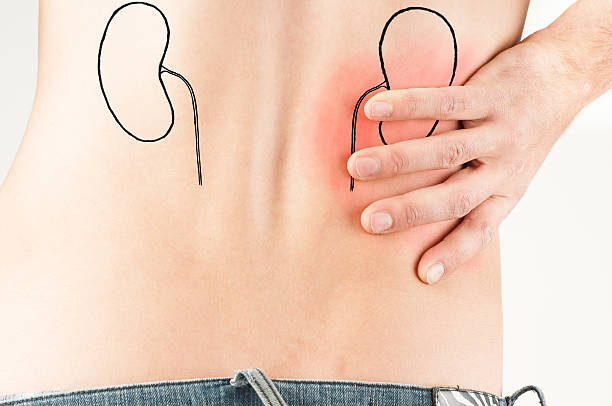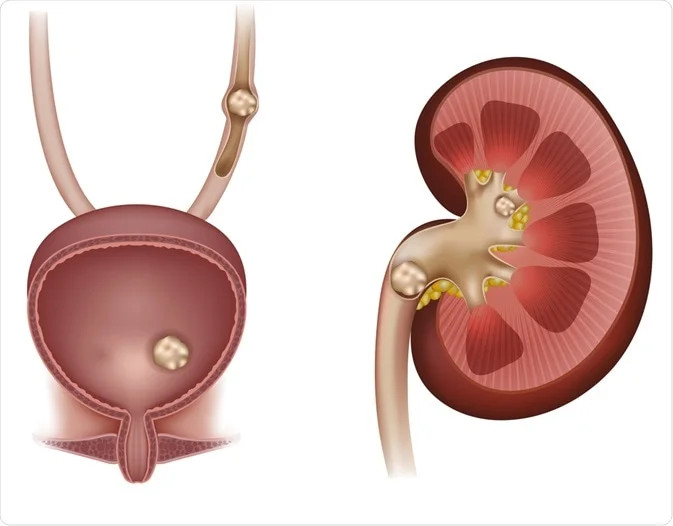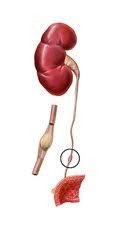Definisi
Kolik renal adalah suatu gejala nyeri karena sumbatan batu di saluran kemih atau saluran urine. Sistem perkemihan berfungsi untuk menyaring zat sisa pada darah dan cairan berlebih, mengeluarkannya dari tubuh dalam bentuk urine. Sistem ini terdiri dari:
- Organ ginjal
- Saluran ureter (saluran yang menghantarkan urine dari ginjal ke saluran kemih)
- Kandung kemih
- Saluran uretra tempat keluarnya urine dari tubuh
5-15% dari populasi masyarakat pernah mengalami kolik renal. Batu ini bisa berada di bagian mana pun di saluran kemih. Ukuran batu juga berbeda, mulai dari seukuran satu butir pasir hingga sebesar bola golf. Rasa nyeri yang ditimbulkan sesuai dengan tingkat sumbatan yang ditimbulkan. Batu yang berukuran sangat besar dapat menimbulkan rasa nyeri hebat karena bisa sangat menyumbat saluran kemih. Sementara itu, batu berukuran kecil dapat keluar dengan sendirinya dan jarang menimbulkan gejala. Penanganan kolik renal disesuaikan dengan penanganan batu saluran kemih.
Penyebab
Penyebab utama dari kolik renal adalah penyakit batu saluran kemih. Batu saluran kemih bisa berada dimana saja dan memiliki berbagai ukuran. Lokasi batu ini bisa berada di ginjal, saluran ureter, atau kandung kemih. Sementara itu, kandungan dari batu saluran kemih yang paling sering ditemukan adalah kalsium dan asam urat. Zat atau mineral pembentuk batu akan menumpuk di saluran kemih, saling menempel, dan membentuk kristal. Semakin lama, ukurannya juga akan bertambah besar.
Semakin besar ukuran batu tersebut, sumbatan yang ditimbulkan akan semakin berat. Ketika urine tidak bisa dengan lancar melewati saluran kemih, maka bisa timbul gejala nyeri kolik renal. Nyeri yang timbul merupakan kombinasi dari:
- Ketegangan pada otot di saluran kemih
- Peradangan yang timbul akibat batu
- Ginjal yang membengkak dan iritasi karena urine tidak bisa keluar dari tubuh dan kembali masuk ke ginjal
Sumbatan batu paling sering terjadi di saluran ureter, saluran yang menghubungkan ginjal dengan kandung kemih. Batu yang tersumbat akan membuat saluran ureter ini mengalami peradangan dan pembengkakan. Ukuran ureter akan membesar dan melebar, sehingga menimbulkan rasa nyeri hebat.
Selain batu saluran kemih, ada beberapa kondisi lain yang juga menyebabkan kolik renal. Beberapa penyakit tersebut adalah:
- Infeksi
- Penyempitan saluran kemih
- Peregangan dan peradangan di otot ureter atau kandung kemih
Faktor Risiko
Faktor risiko kolik renal berhubungan dengan risiko terjadinya batu saluran kemih. Perubahan diet dan pola hidup dapat memengaruhi risiko terjadinya batu saluran kemih dan nyeri kolik renal. Berikut beberapa faktor yang bisa meningkatkan risiko timbulnya kolik renal, antara lain :
- Konsumsi makanan tinggi purin seperti minuman berakohol, daging merah, dll.
- Riwayat batu saluran kemih sebelumnya atau riwayat batu di keluarga
- Dehidrasi karena kurang minum atau kekurangan cairan akibat muntah dan diare
- Penggunaan obat tertentu
- Obesitas
- Penyakit peradangan pada saluran cerna, seperti penyakit Crohn atau kolitis ulseratif
- Operasi bypass lambung, kondisi ini bisa meningkatkan penumpukan kalsium dan zat lain yang membentuk batu saluran kemih
- Kelainan metabolik seperti hiperparatiroid (kondisi dimana kelenjar paratiroid memproduksi terlalu banyak hormon paratiroid
- Penyakit gout, peradangan sendi yang terjadi karena penumpukan kristal asam urat
- Infeksi saluran kemih
Gejala
Gejala kolik renal adalah rasa nyeri yang khas. Nyeri kolik renal bersifat hilang-timbul dan dapat bertahan selama 20 - 60 menit. Nyeri tersebut memiliki karakteristik lain seperti:
- Nyeri hebat pada pinggang belakang atau perut bagian bawah, biasanya nyeri dirasakan hanya pada salah satu sisi tubuh.
- Nyeri menyebar ke punggung, perut bagian bawah, atau selangkangan.
- Mual dan muntah.
Gejala lain yang dapat menyertai nyeri adalah:
- Nyeri saat buang air kecil.
- Perubahan pada urine, seperti:
- Urine bisa disertai darah atau berubah wana menjadi pink, merah, atau coklat
- Urine menjadi keruh atau berbau aneh
- Urine berpasir
- Adanya rasa mendesak untuk buang air kecil
- Mual-muntah
- Buang air kecil lebih sering daripada biasanya
- Demam dan menggigil bila disertai infeksi
Diagnosis
Kolik renal adalah suatu gejala yang menunjukkan adanya penyakit lain yang mendasari keluhan nyeri. Penyakit yang sering menyebabkan rasa nyeri ini adalah batu saluran kemih. Dokter akan mewawancarai pasien untuk menggali gejala dan keluhan yang dirasakan, serta riwayat penyakit pasien. Wawancara medis juga dilanjutkan dengan pemeriksaan fisik dan pemeriksaan penunjang untuk menegakkan diagnosis. Beberapa pemeriksaan yang bisa dilakukan pada keluhan kolik renal adalah:
- Pemeriksaan darah
- Tes urine atau urinalisis, untuk melihat bila pada urine terdapat darah, sel darah putih, tanda infeksi, atau kristal dalam urine.
- Pemeriksaan pencitraan dengan metode USG, X-Ray, atau CT scan pada ginjal dan saluran kemih
- Pemeriksaan ini dijadikan acuan untuk mencari lokasi sumbatan batu saluran kemih dan perkiraan ukurannya.
- Hasil pemeriksaan berguna untuk penentukan terapi yang akan dilakukan.
Bila dari pemeriksaan ini tidak ditemukan adanya kelainan, dokter dapat merujuk Anda ke dokter spesialis urologi untuk pemeriksaan lebih lanjut.
Tata Laksana
Tata laksana awal kolik renal adalah mengatasi nyeri yang timbul. Dokter akan memberikan obat penghilang rasa nyeri untuk sementara waktu. Obat nyeri yang diberikan disesuaikan dengan tingkat nyeri yang dirasakan. Dokter bisa memberikan obat NSAID seperti ibuprofen atau obat untuk mencegah kontraksi otot, yang berfungsi untuk mengurangi peregangan pada otot ureter atau kandung kemih. Anda juga bisa mengompres bagian pinggang belakang atau lokasi perut yang terasa nyeri dengan kompres hangat untuk mengurangi rasa nyeri.
Karena penyebab utama kolik renal adalah batu saluran kemih, terapi akan terfokus untuk mengeluarkan batu tersebut. Batu yang besar membutuhkan beberapa prosedur untuk memecah batu menjadi kecil. Batu berukuran kecil dapat keluar dengan sendirinya bersama aliran urine. Anda bisa meminum banyak air agar tidak kekurangan cairan, dan untuk membantu mengeluarkan batu kecil tersebut. Sementara batu besar yang sudah dipecah menjadi kecil diharapkan dapat keluar bersama urin juga.
Beberapa prosedur yang biasa digunakan untuk memecah batu besar tersebut antara lain:
1. Litotripsi Gelombang Kejut (ESWL)
Prosedur ini menggunakan gelombang kejut yang diarahkan ke lokasi batu kandung kemih. Gelombang kejut akan memecah batu menjadi pecahan batu kecil yang akan keluar bersama urin.
2. Ureteroskopi
Tindakan ini menggunakan selang kecil yang diberikan kamera dan senter di bagian depan. Alat ini akan dimasukan melalui uretra dan kandung kemih untuk mencapai lokasi batu. Kemudian baru akan diambil keluar atau dipecah terlebih dahulu.
3. Nefrolitotomi Perkutaneus
Tindakan ini dilakukan sebagai tindakan operasi karena membutuhkan penyayatan di bagian punggung dan menggunakan alat untuk mengambil batu. Prosedur ini menggunakan obat bius.
4. Stent Ureter
Tindakan ini dilakukan dengan pemasangan selang kecil yang dapat melebarkan saluran ureter dan membuka jalan agar batu dapat keluar.
Komplikasi
Komplikasi pada kolik renal bisa terjadi apabila penyakit penyebab yang mendasari munculnya nyeri tidak tertangani dengan baik. Contohnya, bila kolik renal disebabkan oleh batu saluran kemih yang tidak ditangani dengan baik, maka bisa timbul infeksi saluran kemih dan kerusakan ginjal. Penumpukan urine di dalam ginjal dan saluran kemih yang tersumbat oleh batu juga akan meningkatkan risiko infeksi.
Pencegahan
Pencegahan kolik renal yang dapat dilakukan adalah dengan mencegah pembentukan batu saluran kemih. Beberapa cara yang bisa Anda lakukan adalah:
- Minum air putih yang banyak sesuai kebutuhan tubuh dalam sehari
- Hindari konsumsi minuman bersoda dan alkohol.
- Kurangi konsumsi makanan tinggi garam.
- Batasi konsumsi protein hewani yang tinggi purin pada makanan seperti daging merah.
Kapan Harus ke Dokter?
Segera berobat ke dokter bila Anda mengalami nyeri hebat pada perut bagian bawah atau pinggang dan keluhan terkait buang air kecil. Kolik renal merupakan kondisi gawat darurat yang tidak akan hilang bila kondisi penyebab tidak ditangani segera. Batu saluran kemih juga dapat terjadi berulang kali. Sebaiknya lakukan pemeriksaan bila sebelumnya Anda memiliki riwayat batu ginjal.
Mau tahu informasi seputar penyakit lainnya? Cek di sini, ya!
- dr Hanifa Rahma
Watson, S. (2022). Renal Colic: Symptoms, Treatments, and How Long It Lasts. Healthline. Retrieved 23 June 2022, from https://www.healthline.com/health/renal-colic.
Renal Colic: Causes, Symptoms, Diagnosis & Treatment. Cleveland Clinic. (2022). Retrieved 23 June 2022, from https://my.clevelandclinic.org/health/diseases/22847-renal-colic.
Johnson, J. (2022). Renal colic: Symptoms, treatment, and types. Medicalnewstoday.com. Retrieved 23 June 2022, from https://www.medicalnewstoday.com/articles/320421.
Patti, L., & Leslie, S. (2022). Acute Renal Colic. Ncbi.nlm.nih.gov. Retrieved 23 June 2022, from https://www.ncbi.nlm.nih.gov/books/NBK431091/.












